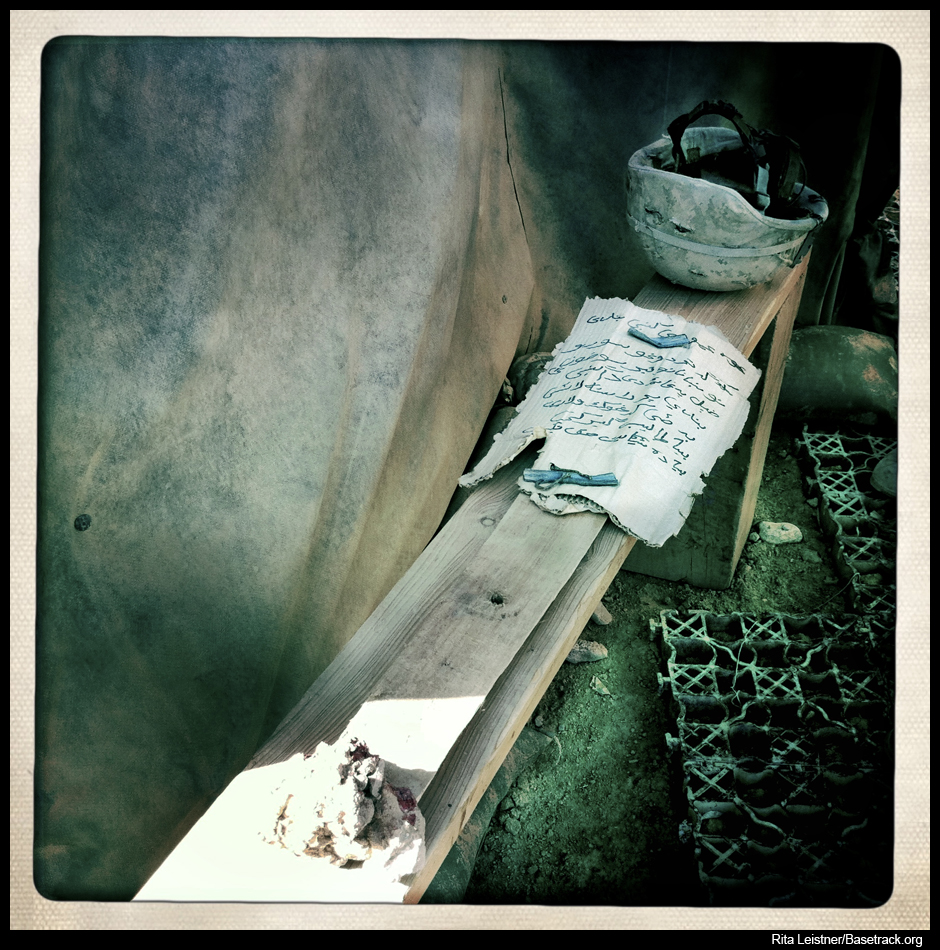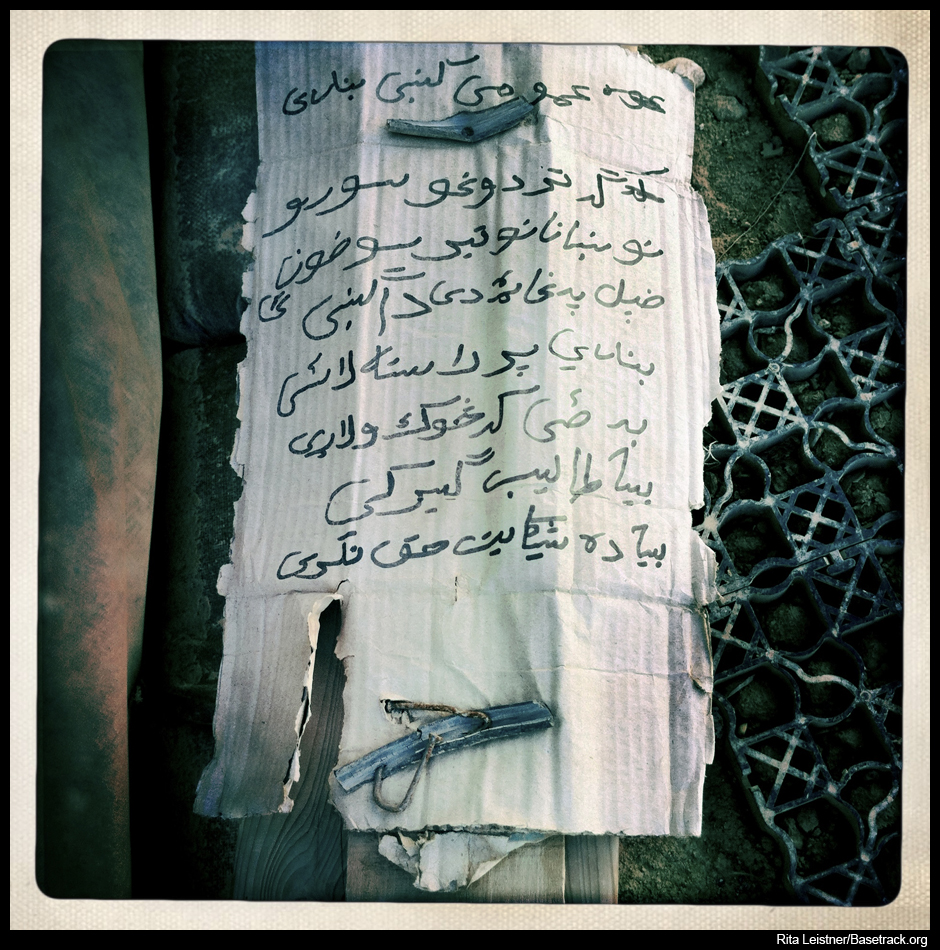Notes
Rita Leistner: Looking for Marshall McLuhan in Afghanistan #2 – That Indecipherable Taliban Message
“Each language draws a magic circle round the people to which it belongs.”
— Marshall McLuhan and Eric McLuhan, Laws of Media: The New Science
It’s safe to say that everything that has to do with Marshall McLuhan begins with language.
One day, some Marines returned to the Shir Ghazay FOB (Forward Operations Base) with a sign they’d found while on patrol. They’d gone out without an interpreter, so they carried it back to base to have it translated. It was handwritten in black marker on corrugated cardboard in a form of Arabic script, presumably Pashto (the dominant language of southern Afghanistan), and was fastened to a two-by-four with some nails and cut pieces of tire rubber. They said that when they found it, it was surrounded by three rocks that someone had painted red.
It’s hard to find enough Afghans with sufficient language skills willing to take the enormous risks of working for foreign militaries. Although most educated Afghans to some extent speak both official languages (Dari and Pashto), the vast majority of interpreters are from the north and Dari (also known as Afghan Persian) is their mother tongue. Dari and Pashto are both of Indo-European origin and both use a modified Arabic script for their writing, but the two languages are not mutually intelligible. The anthropologist Louis Dupree explains that “the difference between Dari and Pashto is analogous to the range of differences between English and German, or French and Spanish” (Dupree, Louis. Afghanistan. Princeton: Princeton University Press, 1980, page 70).
One of the two interpreters on base struggled with the sign. “It’s very badly written,” he said. “I can’t fully make it out. But it is a warning of some kind from the Taliban.” The Marines mistook this to mean that the interpreter couldn’t read his own language, and they told him so. Another interpreter gave it a try and determined the sign had something to do with blocking the way—the three red painted rocks seemed to confirm that interpretation.
In light of their limited training in language, it wasn’t surprising that the Marines didn’t appreciate the difference between Dari and Pashto; nor was it far fetched that many of the Marines thought the Afghans spoke Arabic—many had served in Iraq and recognized the Arabic alphabetic script that is used in Afghanistan. They did no know that the Arabic script had been superimposed over the Persian language during the Islamic Conquest of the 8th century CE, and that historically, Dari and Pashto are actually closer to English than they are to Arabic. Note, for instance, that “the Persian [and Dari] word for ‘is’ is still ast, like Latin est, German ist, Russian yest and Sanskrit asti” (Ostler, Nicholas. Empires of the World: A Language History of the World. New York, Harper Perennial, 2005. P. 108).
The importance of man’s oldest technology—language—is all but ignored in modern military training.
And yet, military conquest and empire building has always been connected to language. In fact we now know without a doubt that the military classes were among those who spread the first alphabet around 2000 BCE because of military rock writing and graffiti discovered by Yale archaeologists John and Deborah Darnell (in the 1993) at the Wadi el-Hôl(Sacks, David. Letter Perfect—The Marvelous History of Our Alphabet from A to Z. New York: Broadway Books, 2003, page 34) along an ancient caravan route from Abidos (in upper Egypt) to Thebes in Greece (Fischer, Stephen Roger. A History of Writing. London: Reaktion Books, Ltd., 2001, page. 84).
“Phonetic script was the indispensible prelude”
— Marshall McLuhan, The Gutenberg Galaxy
The very experience of phonetic literacy (as with the Arabic, Cyrillic, Devanagari, Greek and Roman alphabets) is a fundamental characteristic of those who possess it—which is one of McLuhan’s fundamental tenets. So, however different we may be from whoever wrote that sign, the fact we share phonetic literacy is a more important commonality than that for which we might give credit.
Then there’s the question: with all their technological savvy, why didn’t the Marines just take a photograph of the sign? It was as if they’d forgotten that writing is a visual artifact, and a camera is a photocopier. It all seemed to signify something about the interplay between the old world of analogue and the new digital world.
When I got home from Afghanistan, I showed the photograph I had taken of the sign (a digital media capture of the analogue media hand-written sign) to an Afghan scholar in Toronto—who is fluent in Pashto, Dari and Urdu (a language of northern Pakistan where many Taliban come from)—to see what she could make of it. I had already been told a few different things about the language of the sign, including that part of it was written in what looked like Urdu. As it turns out, the sign is written in a kind of corrupted rural Pashto dialect by someone who had learned reading and writing outside the formal education system, probably at a madrasa (the village, or non-official, schools run by the mullahs, the religious preachers). Nor is the actual script an official Pashto, Dari or Urdu alphabet, but some kind of variant created at the madrasas.
The local nature of the writing meant that it would be nearly impossible for a native Dari speaker to accurately decipher. It would be something like a native English speaker with some formal education in French trying to decipher a French-based pidgin or creole like Haitian, or the language of the Labrador Inuit.
The sign says:
GO BEYOND
THIS POINT
AT YOUR OWN RISK
IF YOU ARE CAPTURED
BY THE TALIBAN
YOUR BLOOD
IS ON
YOUR OWN HANDS
Even had the Marines wanted to return the sign so that others might heed its warning, it would have been too dangerous to go back. We will never know what the consequences were to removing it.
PHOTOGRAPHS by Rita Leistner / Basetrack.org




Reactions
Comments Powered by Disqus